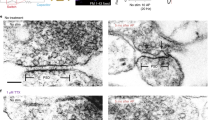Abstract
IN the course of studies on synaptic transmission in the hypogastric ganglia of male guinea pigs it became apparent that in many ganglion cells repetitive stimulation of the hypogastric nerve at 1-Hz raised the frequency of spontaneous synaptic potentials from less than 1 min−1 to about 1 s−1. Many of these cells had only a single preganglionic fibre synapsing with them so that the spontaneous synaptic potentials arising from a single nerve could be readily observed. Blackman et al.1 described large spontaneous synaptic potentials in this preparation and we decided to examine the amplitude distributions of spontaneous synaptic potentials recorded during repetitive stimulation (1Hz). Although ‘spontaneous’ synaptic potentials which were not time locked to the stimulus occurred occasionally during the evoked response, only those recorded after the membrane potential had returned to normal were selected for analysis.
This is a preview of subscription content, access via your institution
Access options
Subscribe to this journal
Receive 51 print issues and online access
$199.00 per year
only $3.90 per issue
Buy this article
- Purchase on Springer Link
- Instant access to full article PDF
Prices may be subject to local taxes which are calculated during checkout
Similar content being viewed by others
References
Blackman, J. G., Crowcroft, P. J., Devine, D. E., Holman, M. E., and Yonemura, K., J. Physiol. Lond., 201, 723 (1969).
Blackman, J. G., Ginsborg, B. L., and Ray, C., J. Physiol. Lond., 167, 374 (1963).
Hubbard, J. I., and Jones, S. F., J. Physiol. Lond., 232, 1 (1973).
Liley, A. W., J. Physiol. Lond., 132, 650 (1956).
Liley, A. W., J. Physiol. Lond., 136, 595 (1957).
Menrath, R. L. E., and Blackman, J. G., Proc. Univ. Otago med. Sch., 48, 72 (1970).
Martin, A. R., and Pilar, G., J. Physiol. Lond., 175, 1 (1964).
Dennis, M. J., Harris, A. J., and Kuffler, S. W., Proc. R. Soc. B, 177, 509 (1971).
Sacchi, O., and Perri, V., Pflügers Archiv., 329, 207 (1971).
Blackman, J. G., and Purves, R. D., J. Physiol. Lond., 203, 173 (1969).
Skok, V. I., Physiology of Autonomic Ganglia (Igaku Shoin Ltd, 1973).
Crowcroft, P. J., Holman, M. E., and Szurszewski, J. H., J. Physiol. Lond., 219, 443 (1971).
Christ, D. D., and Nishi, S., Br. J. Pharmac., 41, 331 (1971).
Crowcroft, P. J., and Szurszewski, J. H., J. Physiol. Lond., 219, 421 (1971).
Perri, V., Sacchi, O., and Casella, C., Pflügers Archiv., 314, 55 (1970).
Author information
Authors and Affiliations
Rights and permissions
About this article
Cite this article
BORNSTEIN, J. Multiquantal release of acetylcholine in mammalian ganglia. Nature 248, 529–531 (1974). https://doi.org/10.1038/248529a0
Received:
Issue Date:
DOI: https://doi.org/10.1038/248529a0
This article is cited by
-
Quantum analysis of postsynaptic potentials
Neurophysiology (1979)
-
Spontaneous activity of the isolated rabbit superior cervical sympathetic ganglion
Neurophysiology (1976)
Comments
By submitting a comment you agree to abide by our Terms and Community Guidelines. If you find something abusive or that does not comply with our terms or guidelines please flag it as inappropriate.



